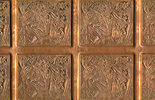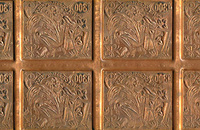Steel engravings, printing plates and extracted images

Engraved and printing plates used in the process of preparation and printing of 1918-39 and 1945-45 Czechoslovak stamps and Czech stamps from 1993 onwards are held in this sub-collection. The original engraved plates are presently used by the Czech Post and Postal Museum for the production of commemorative sheets.
The oldest printing plates, used for the printing of the first Czechoslovak stamps, date back to 1918. The Czechoslovak Post used copper or zinc plates for typographic production of these stamps, while alternative technologies, such as photogravure or printing from chromed-plated copper matrices, which were in use at that time were also tested in cooperation with leading designers (Eduard Karel, Max Švabinský, Alfons Mucha, and others) and Prague-based stamp printing houses (Česká grafická unie and Tiskárna A. Haase). The technology favoured after 1925 was printing from steel plates, first from flat ones and later applying also rotary printing.
The first steel engraved plate made in 1925 represents the beginning of a new technology used to produce Czechoslovak stamps - printing from flat steel plates. The first stamps produced by this technology were the 1, 2 and 3-crown stamps from the issue 75th Birthday of Tomáš Garrigue Masaryk designed by Max Švabinský and engraved by Jaroslav Goldschmied.
The technologies favoured after 1953 were rotary recess printing from steel plates and, from mid-1960s, multicolour printing from flat steel plates used to produce certain stamps and miniature sheets of stamps. The first two-colour stamps were produced by the Prague-based stamp printing house Tiskárna poštovních známek v Praze (established in 1952) using rotary recess printing; the stamps from the issue Transport portraying a steam engine and aircraft Douglas DC 3 were designed by František Postránecký and Albert Jonáš and appeared on 29 December 1952. The first multicolour stamps made by using the recess printing from flat plates technology came out in July 1955 in the issue National Costumes. The next logical step was production of multicolour stamps by rotary recess printing: first such stamps appeared on 25 September 1967 in the issue Animals in Slovak Conservation Areas.
The demanding recess printing from flat plates technology, which depends on the craftsmanship of the engraver and printer, is still used to produce a quantity of Czech stamps. However, the technology used predominantly in stamp design around the world is the simpler and cheaper offset; offset printing has also been used locally, as documented by the archived extracted images (films) and digital carriers. A combination of both methods, i.e. offset and recess printing from flat plates, has also been applied recently; the first stamps so produced came out in May 1998 in the issue Europe - National Festivals and Customs. The stamps were designed by Josef Liesler and engraved by Josef Herčík.
This sub-collection presents masterpieces by leading artists in this area, such as Bohumil Heinz, Karel Seizinger, Jiří Antonín Švengsbír, Jindřich Schmidt, Ladislav Jirka, Václav Fajt, Josef Herčík, Miloš Ondráček and Bedřich Housa.
![Postal museum [logo]](/PostMuzeum-theme/images/muzeum/logo_postal-museum.png)







